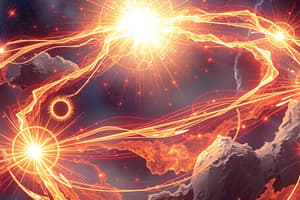Podcast
Questions and Answers
Which concept primarily explains how gravity affects the fabric of space and time?
Which concept primarily explains how gravity affects the fabric of space and time?
- Uncertainty Principle
- Wave-Particle Duality
- General Relativity (correct)
- Quantum States
What does the Uncertainty Principle imply about measuring quantum particles?
What does the Uncertainty Principle imply about measuring quantum particles?
- Particles can be observed without affecting their state.
- Only the position of a particle can be measured.
- Both position and momentum can be accurately determined simultaneously.
- It is impossible to know both the position and momentum of a particle with absolute certainty. (correct)
Which equation represents the relationship between force, mass, and acceleration?
Which equation represents the relationship between force, mass, and acceleration?
- P = W/t
- W = Fd
- F = G(m1*m2)/r²
- F = ma (correct)
What does the Ideal Gas Law express in terms of variables?
What does the Ideal Gas Law express in terms of variables?
Which branch of physics focuses on the laws governing electric and magnetic fields?
Which branch of physics focuses on the laws governing electric and magnetic fields?
What is the relationship described by Newton's Second Law of Motion?
What is the relationship described by Newton's Second Law of Motion?
Which fundamental force is responsible for radioactive decay?
Which fundamental force is responsible for radioactive decay?
What can be said about the conservation of energy?
What can be said about the conservation of energy?
What defines an isothermal thermodynamic process?
What defines an isothermal thermodynamic process?
In the context of wave properties, which term describes the maximum displacement from the rest position?
In the context of wave properties, which term describes the maximum displacement from the rest position?
What happens to the entropy of an isolated system according to the Second Law of Thermodynamics?
What happens to the entropy of an isolated system according to the Second Law of Thermodynamics?
Which of the following best describes electromagnetic waves?
Which of the following best describes electromagnetic waves?
According to Newton's First Law, what occurs when an object is acted upon by no net external force?
According to Newton's First Law, what occurs when an object is acted upon by no net external force?
Flashcards are hidden until you start studying
Study Notes
Key Concepts in Physics
Fundamental Forces
-
Gravitational Force
- Attraction between masses.
- Governed by Newton's law of universal gravitation.
-
Electromagnetic Force
- Interaction between charged particles.
- Includes electric forces (between static charges) and magnetic forces (due to moving charges).
-
Strong Nuclear Force
- Binds protons and neutrons in atomic nuclei.
- Operates at very short ranges.
-
Weak Nuclear Force
- Responsible for radioactive decay and neutrino interactions.
- Has a very short range.
Laws of Motion
-
Newton's First Law (Inertia)
- An object at rest stays at rest, and an object in motion continues in motion unless acted upon by a net external force.
-
Newton's Second Law (F = ma)
- The acceleration of an object is directly proportional to the net force acting on it and inversely proportional to its mass.
-
Newton's Third Law (Action-Reaction)
- For every action, there is an equal and opposite reaction.
Energy
-
Kinetic Energy (KE)
- Energy of motion, calculated as KE = 1/2 mv², where m is mass and v is velocity.
-
Potential Energy (PE)
- Energy stored due to position, commonly gravitational potential energy: PE = mgh, where h is height.
-
Conservation of Energy
- Energy cannot be created or destroyed; it can only be transformed from one form to another.
Thermodynamics
-
First Law of Thermodynamics
- Energy conservation; the change in internal energy equals heat added minus work done by the system.
-
Second Law of Thermodynamics
- Entropy of an isolated system always increases; heat cannot spontaneously flow from a colder body to a hotter body.
-
Thermodynamic Processes
- Isothermal (constant temperature), adiabatic (no heat exchange), isobaric (constant pressure), isochoric (constant volume).
Waves and Oscillations
-
Wave Properties
- Wavelength, frequency, amplitude, speed.
- Types: transverse and longitudinal waves.
-
Sound Waves
- Longitudinal waves that travel through a medium (air, water).
- Speed depends on medium and temperature.
-
Electromagnetic Waves
- Transverse waves that can travel through a vacuum.
- Includes radio waves, microwaves, infrared, visible light, ultraviolet, X-rays, and gamma rays.
Relativity
-
Special Relativity
- Introduced by Einstein; key concepts include the constancy of the speed of light and time dilation.
-
General Relativity
- Deals with gravitation as a curvature of spacetime caused by mass.
Quantum Mechanics
-
Wave-Particle Duality
- Particles exhibit both wave and particle properties (e.g., light behaves as both a wave and a photon).
-
Uncertainty Principle
- Proposed by Heisenberg; it's impossible to know both the position and momentum of a particle with absolute certainty.
-
Quantum States
- Described by wave functions; probabilities are associated with the outcomes of measurements.
Key Formulas
- Force: F = ma
- Work: W = Fd (where d is displacement)
- Power: P = W/t (rate of doing work)
- Momentum: p = mv
- Gravitational Force: F = G(m1*m2)/r²
- Ideal Gas Law: PV = nRT
Branches of Physics
-
Classical Mechanics
- Motion of objects and forces.
-
Electromagnetism
- Study of electric and magnetic fields.
-
Thermal Physics
- Heat, temperature, and the laws of thermodynamics.
-
Quantum Mechanics
- Behavior of particles at atomic and subatomic scales.
-
Relativity
- Effects of gravity and motion on time and space.
-
Astrophysics
- Physical properties and behavior of celestial bodies.
This structured overview summarizes the core ideas and principles of physics, providing a foundation for further study.
Fundamental Forces
- Gravitational force is the attraction between masses and is defined by Newton's law of universal gravitation.
- Electromagnetic force involves the interaction between charged particles, encompassing both electric forces (stationary charges) and magnetic forces (moving charges).
- Strong nuclear force is responsible for binding protons and neutrons in atomic nuclei, effective only at very short distances.
- Weak nuclear force governs processes like radioactive decay and neutrino interactions, characterized by a short range.
Laws of Motion
- Newton's First Law (Inertia) states objects will remain at rest or in uniform motion unless influenced by a net external force.
- Newton's Second Law defines the relationship between acceleration, net force, and mass; expressed as F = ma.
- Newton's Third Law asserts that every action has an equal and opposite reaction, highlighting reciprocal forces.
Energy
- Kinetic energy (KE) signifies energy of motion, calculated using KE = 1/2 mv², where m is mass and v is velocity.
- Potential energy (PE) is energy due to position, commonly gravitational potential energy, calculated as PE = mgh, with h representing height.
- Conservation of energy principle indicates energy cannot be created or destroyed but can be converted between forms.
Thermodynamics
- The First Law of Thermodynamics embodies the conservation of energy, stating that the change in internal energy equals heat added minus work done.
- The Second Law of Thermodynamics asserts that the entropy of an isolated system must increase, stating heat cannot flow spontaneously from a colder to a hotter object.
- Thermodynamic processes include isothermal (constant temperature), adiabatic (no heat exchange), isobaric (constant pressure), and isochoric (constant volume).
Waves and Oscillations
- Wave properties encompass wavelength, frequency, amplitude, and speed; types include transverse and longitudinal waves.
- Sound waves are longitudinal and require a medium (like air or water) for propagation, with speed varying by medium and temperature.
- Electromagnetic waves are transverse and can travel through a vacuum, including categories such as radio waves, microwaves, infrared, visible light, ultraviolet, X-rays, and gamma rays.
Relativity
- Special relativity, introduced by Einstein, centers around the constancy of the speed of light and the concept of time dilation.
- General relativity describes gravitation as the curvature of spacetime, influenced by mass.
Quantum Mechanics
- Wave-particle duality reveals that particles can display both wave-like and particle-like characteristics (e.g., light acts as both a wave and photon).
- The uncertainty principle, formulated by Heisenberg, indicates the impossibility of precisely knowing both a particle's position and momentum simultaneously.
- Quantum states are represented by wave functions, where probabilities dictate the outcomes of measurements.
Key Formulas
- Force: F = ma
- Work: W = Fd (where d is displacement)
- Power: P = W/t (work done over time)
- Momentum: p = mv
- Gravitational Force: F = G(m1*m2)/r² (where G is the gravitational constant)
- Ideal Gas Law: PV = nRT (relation between pressure, volume, temperature, and number of moles)
Branches of Physics
- Classical mechanics deals with the motion of objects and the forces acting upon them.
- Electromagnetism focuses on electric and magnetic phenomena and their interactions.
- Thermal physics investigates heat, temperature, and thermodynamic principles.
- Quantum mechanics studies the behavior of matter and energy at microscopic scales.
- Relativity explores the influence of gravity and motion on the fabric of time and space.
- Astrophysics examines the properties and dynamics of celestial bodies.
Studying That Suits You
Use AI to generate personalized quizzes and flashcards to suit your learning preferences.




